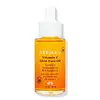What's inside
What's inside
 Key Ingredients
Key Ingredients

 Benefits
Benefits

 Concerns
Concerns

No concerns
 Ingredients Side-by-side
Ingredients Side-by-side

Carthamus Tinctorius Seed Oil
MaskingCaprylic/Capric Triglyceride
MaskingSimmondsia Chinensis Seed Oil
EmollientCoco-Caprylate
EmollientBakuchiol
AntimicrobialTetrahexyldecyl Ascorbate
AntioxidantPanthenyl Triacetate
Tocopheryl Acetate
AntioxidantHelichrysum Arenarium Extract
AntiseborrhoeicTanacetum Annuum Flower/Leaf/Stem Oil
MaskingPrunus Armeniaca Kernel Oil
MaskingPrunus Domestica Seed Oil
Skin ConditioningMorus Alba Leaf Extract
Skin ConditioningSqualane
EmollientHelianthus Annuus Seed Oil
EmollientAcetyl Zingerone
AntioxidantCarthamus Tinctorius Seed Oil, Caprylic/Capric Triglyceride, Simmondsia Chinensis Seed Oil, Coco-Caprylate, Bakuchiol, Tetrahexyldecyl Ascorbate, Panthenyl Triacetate, Tocopheryl Acetate, Helichrysum Arenarium Extract, Tanacetum Annuum Flower/Leaf/Stem Oil, Prunus Armeniaca Kernel Oil, Prunus Domestica Seed Oil, Morus Alba Leaf Extract, Squalane, Helianthus Annuus Seed Oil, Acetyl Zingerone
Caprylic/Capric Triglyceride
MaskingHelianthus Annuus Seed Oil
EmollientNeopentyl Glycol Diethylhexanoate
EmollientTetrahexyldecyl Ascorbate
AntioxidantSimmondsia Chinensis Seed Oil
EmollientRubus Idaeus Seed Oil
EmollientVaccinium Macrocarpon Seed Oil
Skin ConditioningHippophae Rhamnoides Seed Oil
Skin ProtectingCurcuma Longa Root Oil
PerfumingZingiber Officinale Root Oil
MaskingTocopheryl Acetate
AntioxidantMica
Cosmetic ColorantTitanium Dioxide
Cosmetic ColorantIron Oxides
Parfum
MaskingCaprylic/Capric Triglyceride, Helianthus Annuus Seed Oil, Neopentyl Glycol Diethylhexanoate, Tetrahexyldecyl Ascorbate, Simmondsia Chinensis Seed Oil, Rubus Idaeus Seed Oil, Vaccinium Macrocarpon Seed Oil, Hippophae Rhamnoides Seed Oil, Curcuma Longa Root Oil, Zingiber Officinale Root Oil, Tocopheryl Acetate, Mica, Titanium Dioxide, Iron Oxides, Parfum
Ingredients Explained
These ingredients are found in both products.
Ingredients higher up in an ingredient list are typically present in a larger amount.
This ingredient is an emollient, solvent, and texture enhancer. It is considered a skin-softener by helping the skin prevent moisture loss.
It helps thicken a product's formula and makes it easier to spread by dissolving clumping compounds.
Caprylic Triglyceride is made by combining glycerin with coconut oil, forming a clear liquid.
While there is an assumption Caprylic Triglyceride can clog pores due to it being derived from coconut oil, there is no research supporting this.
Learn more about Caprylic/Capric TriglycerideHelianthus Annuus Seed Oil is the oil derived from the seeds of a Sunflower. Sunflower seed oil is non-fragrant. It is an emollient, meaning it helps to soften the skin.
Sunflower seed oil contains many fatty acids. The fatty acids found in sunflower seeds include (from highest amount to least): linoleic acid, myristic acid, palmitic acid, stearic acid, arachidic acid, oleic acid, and linolenic acid.
These fatty acids help the skin create ceramides. Ceramides play a role in repairing the skin barrier.
Helianthus Annuus Seed Oil helps moisturize the skin. This in turn helps the skin look more rejuvenated and smoother.
Sunflowers are rich in vitamin E.
Historians believe Indigenous cultures of North America domesticated sunflowers before corn. Thus they relied on sunflower oil for a variety of uses. One such use is moisturizing skin and hair.
Sunflower seed oil may not be fungal acne safe. We recommend speaking with a professional if you have any concerns.
Learn more about Helianthus Annuus Seed OilThis oil comes from the seeds of the desert shrub called Jojoba. It is more commonly known as jojoba oil, a non-comedogenic oil.
Jojoba oil does not contain fragrance and has many fatty-acids, making it a great soothing ingredient.
It also contains Vitamin E, a great moisturizing ingredient. Vitamin E is also an antioxidant and protects your skin against oxidative damage.
This ingredient humectant properties, meaning it helps draw moisture from the air. This helps keep your skin hydrated.
While jojoba has antibacterial properties, it is only able to kill some strains of bacteria.
Studies also show it helps in wound healing. In fact, Indigenous cultures have used jojoba as a moisturizer and to help treat burns for centuries.
Fun fact: Jojoba oil similar to natural human skin sebum, so it has a great effect on dry skin. It is also promising with helping to regulate sebum production.
Due to its fatty acid content, Jojoba oil may not be fungal acne safe. We recommend speaking with a professional if you have any concerns.
Learn more about Simmondsia Chinensis Seed OilTetrahexyldecyl Ascorbate (THD) is a stable and oil-soluble form of Vitamin C.
THD is special in that it has the ability to travel deeper into skin than traditional ascorbic acid while maintaining the same skin benefits (double win!).
Because it’s oil-soluble, THD dives deep into your skin’s fatty layers (think ceramides and cholesterol) to fight off the kind of free radicals that mess with your skin barrier. This makes it a great pair with water-based vitamin C (ascorbic acid) that mainly works on the surface.
Even at just 0.1%, THD is already showing great antioxidant activity. When used up to 2%, it helps keep your skin happy and calm, especially when it’s stressed from pollution or sun.
Want to fade dark spots or tackle hyperpigmentation? You’ll want 5% or more. Pairing it with brightening buddies like niacinamide or licorice root gives even better results. One study even used 30% THD with other brighteners and saw real results on stubborn discoloration, even in melasma-prone skin.
A note on THD: It’s has a slightly silky, oily texture and usually shows up colorless or pale yellow (though the exact shade can vary by supplier).
While you can sneak it into water-based formulas, it really shines when paired with silicones or oils, which help your skin soak it up better.
THD is pretty stable, but it’s still vulnerable to degradation like ascorbic acid. Too much light or heat (above 113°F / 45°C) can break it down over time. Go for dark and opaque packaging that keeps it safe and shady!
Read more about other types of Vitamin C:
Learn more about Tetrahexyldecyl AscorbateTocopheryl Acetate is AKA Vitamin E. It is an antioxidant and protects your skin from free radicals. Free radicals damage the skin by breaking down collagen.
One study found using Tocopheryl Acetate with Vitamin C decreased the number of sunburned cells.
Tocopheryl Acetate is commonly found in both skincare and dietary supplements.
Learn more about Tocopheryl Acetate